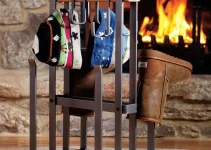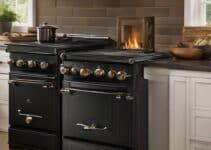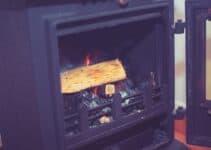In my experience as a writer for Village and Cottage, I understand that discerning the firebox vs log burner differences is a pressing issue for many looking to optimise their home heating. It strikes me that with the climbing costs of fuel, the drive for sustainable heating solutions has heightened the necessity for clear information.
A firebox, as defined by the Stove Industry Alliance, is the compartment within a fireplace where the fire is made, contrasting with a log burner – a wood burning stove that stands alone as a heating appliance. In this forthcoming article, I aim to draw out a distinct firebox vs log burner comparison, casting a light on the complications of fire safety, building regulations, and insurance considerations when choosing either of them for your space.
Whether it’s the enveloping warmth of a fireplace or the robust efficiency of a wood burning stove, my journey into the heart of these differences will elucidate the particular qualities each appliance offers. Please join me as I delve into the intricacies of these two heating options.
Understanding the Essentials: Firebox and Log Burner Overview
When I engage with readers interested in optimising their home heating, many are curious about the core functionalities of a firebox and a log burner. To many, the term ‘firebox’ may seem rather enigmatic, but it specifically designates the chamber within a fireplace where the actual process of combustion takes place. A log burner, conversely, alludes to an independent wood-burning stove, esteemed for its superior efficiency and the delightfully cosy atmosphere it can bestow upon a room.
Ascertaining the distinguishing features of each can be instrumental for homeowners who ponder over the types of heating appliances that align with their lifestyle. A firebox is integral to the fireplace, a traditional centerpiece in homes that aesthetically draws one’s attention; however, it is the log burner that often comes to the forefront when considering fuel consumption and heating efficiency.
My role is to elucidate the disparities between these two entities to help readers make an informed decision. Let’s delve into their characteristics:
- The firebox is a part of the fireplace structure, typically lined with firebricks or metal, and designed to sustain direct contact with open flames.
- A log burner, or wood stove, is generally a freestanding unit constructed from robust materials like cast iron or steel, which radiates heat throughout the space.
Nevertheless, the choice between a firebox and a log burner is not solely based on aesthetics or traditional values; it fundamentally revolves around practical efficiency, which in turn impacts the household’s fuel consumption. Here’s an overview of their efficiency dynamics:
| Heating Appliance | Combustion Efficiency | Fuel Consumption |
|---|---|---|
| Firebox | Medium | Higher |
| Log Burner | High | Lower |
Achieving the perfect blend of comfort, efficiency, and style is paramount, and understanding these aspects of fireboxes and log burners lays the groundwork for making an appropriate choice that resonates with both the heart and practicalities of home heating.
Join me in the subsequent sections as we delve further into the nuances that might affect your choice between the warmth of a firebox and the functionality of a log burner.
Firebox vs Log Burner Differences: Clarifying the Confusion
As a seasoned journalist in the home heating sector, I’ve observed a considerable amount of confoundment regarding the distinctions between fireboxes and log burners. Both serve as fundamental components in home heating, yet they differ significantly in design, efficiency, and environmental impact.
The typical firebox is an integral part of a fireplace’s architecture, commonly made of metal or firebrick, and allows for the careful control of airflow to manage the combustion process. Contemporary versions, particularly inserts or cassettes for wood-burning fireplaces, adhere to rigorous tests, underlining their advances over standard fireboxes. Conversely, a log burner is a self-contained wood burning stove that stands apart for its increased efficiency and environmental consideration.
Compliance with recent Ecodesign regulations is integral for log burners, reflecting a commitment to minimising emissions from the burning of solid fuels. This factor is particularly crucial given the escalating importance of sustainable practices in the home heating domain. I have outlined below the key contrasts between fireboxes and log burners to assist enthusiasts and homeowners in making informed decisions that align with their heating needs and eco-responsibilities.
| Feature | Firebox | Log Burner |
|---|---|---|
| Design | Part of a fireplace’s structure | Standalone heating appliance |
| Material | Metal or firebrick | Various options incl. cast iron or steel |
| Efficiency | Variable, depending on design | Generally higher due to advanced technology |
| Environmental Impact | Depends on airflow management and use | Subject to Ecodesign requirements, lower emissions |
| Regulations | May vary by local standards | Must comply with current Ecodesign requirements |
My expert advice is to evaluate the distinctive features of both heating systems and consider the long-term implications of efficiency and environmental impact before making the final decision. Whether it involves selecting a traditional fireplace enhanced by a refined firebox or opting for a highly efficient wood burning stove, the key lies in discerning these critical distinctions.
Diving Into Definitions: What is a Firebox?
Unveiling the intricacies of a firebox is tantamount to exploring the very heart of a fireplace. As a writer well-versed in the subject of home heating, I feel compelled to elucidate the significance of this term which is oftentimes shrouded in ambiguity. A firebox represents the section within a fireplace that is designed to contain the combustion of firewood or other types of fuel. As I delve deeper into the anatomy of this element, it’s imperative to acknowledge that it’s constructed from non-combustible material to ensure safety and efficiency.
The evolution of firebox technology interfaces closely with environmental impact concerns. Modern firebox models are not merely about withstanding the high temperatures of combustion but also about improving the heating capability of the fireplace while reducing the carbon footprint of its operation.
Aside from providing warmth and comfort, the advanced firebox inserts are crafted to facilitate better air circulation and fuel efficiency. They play a transformative role in elevating the functionality of an existing hearth, consequently breathing new life into traditional home heating methods. Below is an overview of the typical materials used to construct a firebox and their associated benefits:
| Material | Heat Retention | Durability | Eco-Friendliness |
|---|---|---|---|
| Metal | Good | Excellent | Moderate |
| Firebrick | Superior | Very Good | High |
| Engineered Systems | Advanced | Dependent on Design | Optimal |
As we dissect the fabric of the firebox, it becomes abundantly clear that it’s a silent yet powerful protagonist in the narrative of eco-conscious heating. It stands as a testament to human ingenuity – a marriage of robust, resilient architecture and a custodian of our environment. Ultimately, the selection of a firebox, whether for a new installation or as an upgrade to an existing fireplace, must take into account a delicate balance between performance aspirations and environmental stewardship.
Exploring the Log Burner: Function and Build
In my exploration of heating appliances, the log burner consistently marks its presence with a legacy that integrates tradition with innovation. Known colloquially as a wood-burning stove, these stoves have vastly evolved from their primitive forerunners. The contemporary log burner is a remarkable fusion of design and functionality, a freestanding unit crafted from resilient materials like cast iron or steel, which not only endure the test of time but also complement a variety of interior decors.
The quintessential character of a wood-burning stove lies in its combustion efficiency, a critical component that discerns it from the conventional fireplace. With advanced engineering, modern log burners have perfected the art of fuel consumption, making them significantly more adept at heating extensive areas whilst minimising waste. The ingenious use of a self-contained firebox, coupled with an efficient ventilation system, ensures that these stoves deliver sustained warmth with greater thermal output, hence why many of my readers lean towards this heating solution for both its practical and aesthetic benefits.
Beyond the allure of a cosy hearth, the environmental impact of log burners is an imperative aspect augmenting their appeal. Wood, as a renewable resource, when burnt in these high-efficiency stoves, releases a fraction of the particulates compared to open fires, aligning with contemporary eco-conscious sensibilities. As I assess heating options, the lower emissions and efficient wood combustion offered by log burners place them as a responsible choice for those endeavouring to shrink their carbon footprint whilst savouring the homely ambiance that only a wood-burning stove can provide.



